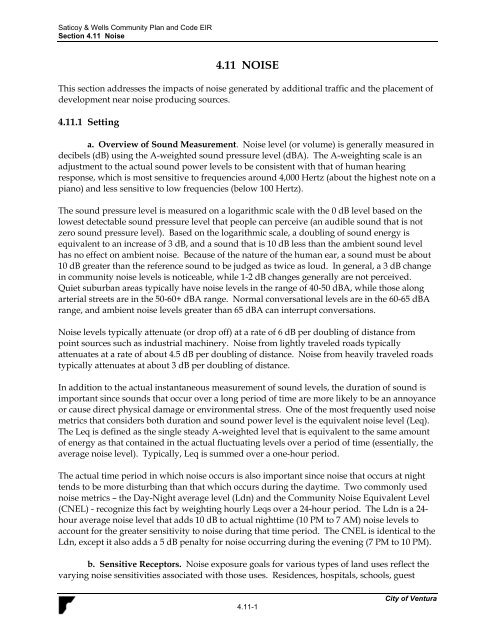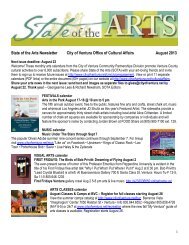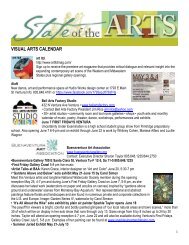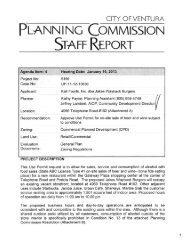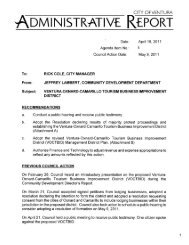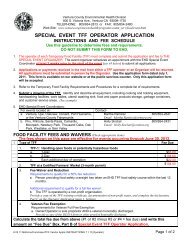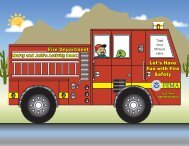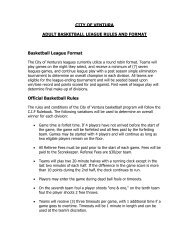Saticoy & Wells Community Plan & Development ... - City Of Ventura
Saticoy & Wells Community Plan & Development ... - City Of Ventura
Saticoy & Wells Community Plan & Development ... - City Of Ventura
Create successful ePaper yourself
Turn your PDF publications into a flip-book with our unique Google optimized e-Paper software.
<strong>Saticoy</strong> & <strong>Wells</strong> <strong>Community</strong> <strong>Plan</strong> and Code EIRSection 4.11 Noise4.11 NOISEThis section addresses the impacts of noise generated by additional traffic and the placement ofdevelopment near noise producing sources.4.11.1 Settinga. Overview of Sound Measurement. Noise level (or volume) is generally measured indecibels (dB) using the A-weighted sound pressure level (dBA). The A-weighting scale is anadjustment to the actual sound power levels to be consistent with that of human hearingresponse, which is most sensitive to frequencies around 4,000 Hertz (about the highest note on apiano) and less sensitive to low frequencies (below 100 Hertz).The sound pressure level is measured on a logarithmic scale with the 0 dB level based on thelowest detectable sound pressure level that people can perceive (an audible sound that is notzero sound pressure level). Based on the logarithmic scale, a doubling of sound energy isequivalent to an increase of 3 dB, and a sound that is 10 dB less than the ambient sound levelhas no effect on ambient noise. Because of the nature of the human ear, a sound must be about10 dB greater than the reference sound to be judged as twice as loud. In general, a 3 dB changein community noise levels is noticeable, while 1-2 dB changes generally are not perceived.Quiet suburban areas typically have noise levels in the range of 40-50 dBA, while those alongarterial streets are in the 50-60+ dBA range. Normal conversational levels are in the 60-65 dBArange, and ambient noise levels greater than 65 dBA can interrupt conversations.Noise levels typically attenuate (or drop off) at a rate of 6 dB per doubling of distance frompoint sources such as industrial machinery. Noise from lightly traveled roads typicallyattenuates at a rate of about 4.5 dB per doubling of distance. Noise from heavily traveled roadstypically attenuates at about 3 dB per doubling of distance.In addition to the actual instantaneous measurement of sound levels, the duration of sound isimportant since sounds that occur over a long period of time are more likely to be an annoyanceor cause direct physical damage or environmental stress. One of the most frequently used noisemetrics that considers both duration and sound power level is the equivalent noise level (Leq).The Leq is defined as the single steady A-weighted level that is equivalent to the same amountof energy as that contained in the actual fluctuating levels over a period of time (essentially, theaverage noise level). Typically, Leq is summed over a one-hour period.The actual time period in which noise occurs is also important since noise that occurs at nighttends to be more disturbing than that which occurs during the daytime. Two commonly usednoise metrics – the Day-Night average level (Ldn) and the <strong>Community</strong> Noise Equivalent Level(CNEL) - recognize this fact by weighting hourly Leqs over a 24-hour period. The Ldn is a 24-hour average noise level that adds 10 dB to actual nighttime (10 PM to 7 AM) noise levels toaccount for the greater sensitivity to noise during that time period. The CNEL is identical to theLdn, except it also adds a 5 dB penalty for noise occurring during the evening (7 PM to 10 PM).b. Sensitive Receptors. Noise exposure goals for various types of land uses reflect thevarying noise sensitivities associated with those uses. Residences, hospitals, schools, guest4.11-1<strong>City</strong> of <strong>Ventura</strong>


